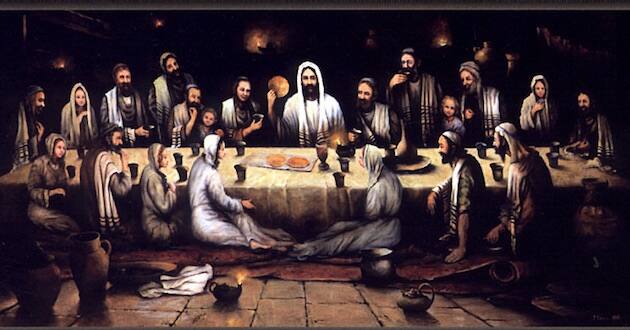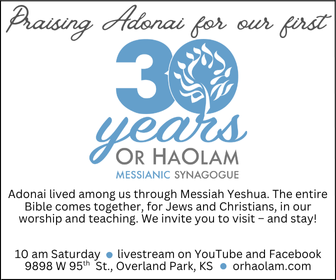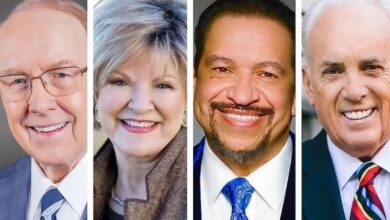
Pesakh (Passover) begins on the 15th day of the Jewish month of Nissan. The name “Pesakh” (PAY-sahkh, with a “kh” as in the Scottish “lokh”) comes from the Hebrew root Peh-Samekh-Khet, meaning to pass through, to pass over, to exempt or to spare. It refers to the fact that G-d “passed over” the houses of the Jews when he was slaying the firstborn of Egypt. In English, the holiday is known as Passover. “Pesakh” is also the name of the sacrificial offering (a lamb) that was made in the Temple on this holiday.
The holiday is also referred to as Khag he-Aviv, (the Spring Festival), Khag ha-Matzot, (the Festival of Matzahs), and Z’man Kherutenu, (the Time of Our Freedom). Agriculturally, it represents the beginning of the harvest season in Israel.
Passover is the oldest, and in many ways the most deeply impacting of the Biblical holidays. It is designated the beginning of the year in Va-yeek-ra (Leviticus) 23, and is, humanly speaking, an unlikely story for the origin of Jewish national identity. . . Moshe (Moses) himself says in D’varim (Deuteronomy) 4:32 – 34:
For ask now concerning the days that are past, which were before you, since the day that G-d created man on the earth, and ask from one end of heaven to the other, whether any great thing like this has happened, or anything like it has been heard. Or did G-d ever try to go and take for Himself a nation from the midst of another nation, by trials, by signs, by wonders, by war, by a mighty hand and an outstretched arm, and by great terrors, according to all that Adonai your G-d did for you in Egypt before your eyes?
Who wants to believe that they were descendants of slaves? Who wants to believe that they were “powerless” until someone else saved them? This story shows the power that G-d alone has to deliver from slavery. That power is not abated to deliver us from our current forms of spiritual, emotional, and personal “Egyptian” slavery.
READ: Archaeologists announce Exodus evidence
The primary observances of Pesakh are related to the exodus from Egypt after generations of slavery. This story is told in Sh’mot (Exodus) 1-15. Many of the Pesakh observances are instituted in Chapters. 12-15.
Pesakh lasts for seven days according the Bible and Sephardic Jews [Spanish and North African]. European Jewish rabbis have added an eighth day of unleavened bread. The first and seventh days of the holiday are days on which no work is permitted. Work is permitted on the intermediate days. These intermediate days on which work is permitted are referred to as Khol Ha-Mo’ed.
During the week of Passover, the precept that “’You shall eat nothing leavened” is applied. Although we don’t pretend to keep our meals and homes “glat kosher,” the Passover ritual is clear and fraught with rich significance. This is why we eat no breads, bagels, breaded chicken, pastas, cakes, cookies, pie crusts, etc., at our meals during this time.
One of the most intense observances related to Pesakh involves the removal of khametz (leaven; sounds like “khum-ate’s”) from our homes. This commemorates the fact that the Jewish people leaving Egypt were in a hurry, and did not have time to let their bread rise. It is also a symbolic way of removing the “puffiness” (arrogance, pride) from our souls. The process of cleaning the home of all khametz in preparation for Pesakh is an enormous task. To do it right, you must prepare for several weeks and spend several days scrubbing everything down. After the cleaning is completed, the morning before the seder, a formal search of the house for khametz is undertaken, and any remaining khametz is burned.
VIDEO: Family hosts virtual Passover Seder
Khametz includes anything made from the five major grains (wheat, rye, barley, oats and spelt) that has not been completely cooked within 18 minutes after coming into contact with water. Orthodox Jews of Ashkenazic background also avoid rice, corn, peanuts, and legumes (beans) as if they were khametz. All of these items are commonly used to make bread, thus use of them was prohibited to avoid any confusion.
Such additional items are referred to as “kitniyot.”
The grain product we may eat during Pesakh is called matzah. Matzah is unleavened bread, made simply from wheat flour and water and baked very quickly. This is the bread that the Jews made for their flight from Egypt. There are many inventive ways to use matzah; it is available in a variety of textures for cooking: matzah flour (finely ground for cakes and cookies), matzah meal (coarsely ground, used as a bread crumb substitute), matzah farfel (little chunks, a noodle or bread cube substitute), and full-sized matzahs (about 10 inches square, a bread substitute).
THE SEARCH FOR LEAVEN
We are told in Sh’mot (Exodus) 13:6-7: “And no khamayts, (leavened bread) shall be seen among you, nor shall leaven be seen among you in all your quarters.” The Messianic Writings spiritual application of this is: “It takes only a little khamayts (leaven, or yeast) to leaven a whole batch of dough? Get rid of the old khamayts so that you can be a new batch of dough, because in reality you are unleavened. For our Pesakh lamb, the Messiah, has been sacrificed. So let us celebrate the seder not with leftover khamayts, the khamayts of wickedness and evil, but with the matzah of purity and truth.” 1 Cor. 5: 6–8.
There is a ceremonial conclusion to the removal of the leaven in Jewish homes. Taking place the evening before the first Seder, (except when Passover begins on a Saturday night), this ceremony is the climax of the Passover preparation. Ten pieces of leavened products, khamayts are hidden around the house. The family gathers together with a candle for lighting the way, a feather for brushing-up the khamayts and a wooden spoon onto which the khamayts is brushed. If you prefer, a flashlight and small hand broom and dustpan work equally well. Everything can be burned the next day with the rest of the leaven. The ceremony should involve the children and be performed immediately after supper. A prayer for HaShem to help us search our hearts for spiritual khamayts, leaven, is in order.
THE BURNING OF LEAVEN
The crumbs of bread that have been gathered the night before are put together in a bundle and burned the morning before Passover. We can apply this object lesson of cleaning to our homes and our spirits, our relationships vertical and horizontal. Let us search our hearts and lives, and remove the spiritual khamayts, and then ask the Spirit to burn the rest.
When Pesakh begins on Shabbat, that is, on Saturday night after the Sabbath has concluded, this complicates the process of preparing for Pesakh, because many of the preparations normally undertaken on the day before Pesakh cannot be performed on Shabbat. The Fast of the Firstborn is normally observed on the day before Pesakh.
On the first night of Pesakh (first two nights for traditional Jews outside Israel), we have a special family meal filled with ritual to remind us of the significance of the holiday. This meal is called a seder, from a Hebrew root word meaning “order,” because there is a specific set of information that must be discussed in a specific order. It is the same root from which we derive the word “siddur”, (prayer book). The second night of Pesakh coincides with the beginning of Sefira (Counting the Omer).
THE PASSOVER SEDER
The special home ceremony on the first night of Passover, the seder or shulkhan arukh (“ordered table”), is based on the injunction to parents to inform their children of the deliverance from Egypt: “On that day you are to tell your son, ‘It is because of what ADONAI did for me when I left Egypt.’” Sh’mot (Exodus) 13:8.
Yeshua and his disciples celebrated Passover by having a meal together and enjoying the fellowship of community of faith.
PESAKH – SHULKHAN ARUKH (ORDERED TABLE)
1. THE FIRST CUP – THE CUP OF SANCTIFICATION
To begin the Seder, everyone’s cup is filled with the fruit of the vine and all drink together, recalling the first– “I will,” from Sh’mot (Exodus) 6: “I will bring you out from under the burdens of the Egyptians.” This symbolizes separating ourselves from the unholy so we can dedicate ourselves to Adonai.
2. WASHING OF HANDS
 Hand washing is a symbol of the purity required to enter Adonai’s presence in His Holy Temple. A bowl of water or a special hand washing container is passed around the table so everyone can dip their hands in it. Tehillim (Psalms) 24:3,4 “Who may go up to the mountain of Adonai? Who can stand in His holy place? Those with clean hands and pure hearts, who don’t make vanities the purpose of their lives or swear oaths just to deceive.”
Hand washing is a symbol of the purity required to enter Adonai’s presence in His Holy Temple. A bowl of water or a special hand washing container is passed around the table so everyone can dip their hands in it. Tehillim (Psalms) 24:3,4 “Who may go up to the mountain of Adonai? Who can stand in His holy place? Those with clean hands and pure hearts, who don’t make vanities the purpose of their lives or swear oaths just to deceive.”
3. DIPPING OF PARSLEY
Everyone is given a sprig of parsley which they dip in salt-water and then eaten, symbolizing the hyssop twigs which the Israelites used to marked their doors with the slain lamb’s blood.
The salt water represents the tears shed in bondage.
4. THREE MATZOT
The leader takes and breaks the middle matzoh into two pieces from a stack of three and hides half of it. The hidden matzoh, called the afikomen, means dessert, which will be eaten at the end of the meal as a remembrance for the Passover sacrifice. It also means “He who comes.” The other half is returned to its place as the “bread of affliction,” upon which the blessing will be recited “for eating matzoh.
5. THE HAGGADAH

Haggadah means “retelling.” The Passover story from the book of Sh’mot (Exodus) is read again, usually with each one participating in the reading of the events.
6. THE FOUR QUESTIONS
The youngest child asks four questions regarding the four unusual Passover customs: Why is this night different from all other nights:
- On all other nights we eat either hametz or matzah, but on this night only matzoh?
- On all other nights we eat all kinds of herbs, but on this night only bitter herbs?
- On all other nights we do not dip even once, but on this night twice?
- On all other nights we eat either sitting or reclining, but on this night we all recline?
7. THE SECOND CUP – THE CUP OF JUDGMENT
“I will rescue you from their oppression” Sh’mot (Exodus) 6:6. Everyone’s cup is refilled. Then the Ten Plagues are recounted, and at the mention of each plague we spill a drop of grape juice or wine from our cups. We do not drink the wine which was spilled out.
8. MATZOH
Now the Matzoh which is unleavened is eaten. It symbolizes the haste with which the children of Israel left Egypt.
9. BITTER HERBS
Bitter Herbs are eaten with matzoh, symbolizing the bitterness of the Israelites’ slavery. Everyone partakes and meditates on the bitterness of bondage.
10. KHAROSET
Represents the bricks and mortar made in slavery. This is a tasty mixture of apples, nuts, honey and wine. It is eaten with matzoh.
11. THE BEITZAH
A hard boiled egg is eaten in remembrance of the Temple sacrifices which are now no longer offered.
12. NOW THE MEAL IS SERVED
A typical Passover meal will be roasted chicken, beef or lamb served with vegetables. No grains or food with leaven will be served.
13. AFIKOMEN
Children search for the afikomen and receive a sweet reward for their efforts. Those who search for salvation through Yeshua the Messiah will find Him and enjoy the sweetness of fellowship with Messiah.
14. THE THIRD CUP – THE CUP OF REDEMPTION
The cups are refilled and all drink together. “I will redeem you with an outstretched arm and with great judgments” Exodus 6 : 6 . Yeshua, the Messiah said, “This cup is the New Covenant, ratified by my blood, which is being poured out for you” Luke 22:20.
15. ELIJAH’S PLACE
Reference is made to the empty chair and place setting for the prophet Elijah, and forerunner of Messiah.
16. THE PSALMS
Praises are read from the book of Psalms.
17. THE FOURTH CUP – THE CUP OF PRAISE
“I will take you as my people” Exodus 6:7.
18. CONCLUSION
The Seder concludes as all say in unison:
“Next Year in Jerusalem!”
And there is more singing and dancing!
–Guest Column by Shmuel Wolkenfeld, Messianic Rabbi, Or HaOlam Messianic Synagogue.











